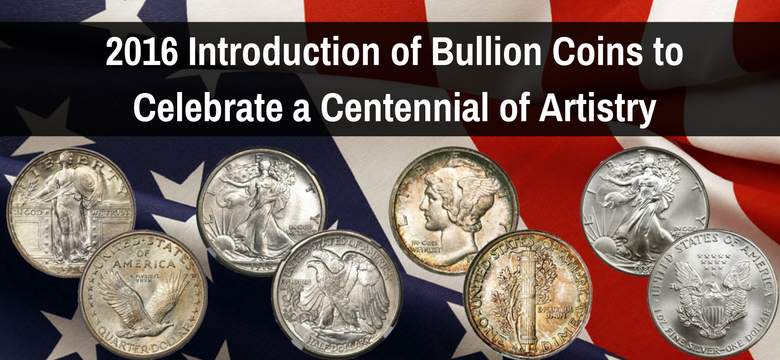One hundred years ago, 1916 was a banner year for numismatics. After Charles Barber’s eponymous designs had graced the Barber Quarter, Barber Dime, and Barber Half Dollar from 1892 to 1915, each of these three denominations received distinct facelifts the following year with new, fresh designs.
This was a break from tradition because each of the three denominations—quarter, dime, and half dollar—were to have different designs from each other. Previously, based on practices that were common in Europe, the tendency for American coinage was for those three silver coin types to share either the same or very similar designs. This held true for the Bust Coinage of the 1790s to 1830s and the Seated coinage of the 1830s to 1890s. In both cases, the coin designs for quarters, dimes, and half dollars were all identical or nearly so.
In the Progressive Era that ended in the early 1920s, however, there was a broad spirit of reform and progress that extended even to the staid practices of the US Mint. As dramatic changes occurred in the United States, going from horse to car and from peace to World War I, change was afoot in our coinage. Designs were sought from specific artists believed to be of merit by the US Mint and the recently-created Commission of Fine Arts for their review. Models and sketches were prepared, and deliberations ensued.
Eventually, three much-loved coin designs were chosen: Adolf A. Weinman’s Mercury (Winged Liberty) Dime and Walking Liberty Half Dollar as well as Hermon A. MacNeil’s Standing Liberty Quarter. Interestingly enough, among widespread praise for these designs came an unexpected controversy. In the earliest Standing Liberty Quarters of 1916 and early 1917, the breast of MacNeil’s figure of Liberty was initially exposed on the first coins to be released. Rather than being considered artful, MacNeil’s design was later adjusted and Liberty covered with a chain mail shirt, creating the so-called “Type Two” design of later 1917, resulting in two variants of the coin from this second year of production.
That controversy aside, these three new designs of 1916 proved to be tremendously popular both at the time of production and also many years later with collectors. While he could not have known the broad impact that his designs would have at the time, Weinman’s Walking Liberty design proved so perennially popular that many years later, in 1986, it was reprised as the Silver Eagle design, used by the Mint for one-ounce silver bullion coins.
More recently, in 2016, the US Mint has arranged to release each of these three designs as gold bullion coins for collectors. A 2016 gold Mercury Dime, gold Standing Liberty Quarter, and gold Walking Liberty half dollar were arranged to be released, beginning with the smallest denomination of the dime. While only the dime and the quarter have been released at the time of writing, we look forward to seeing this new iteration of these classic designs become available to the public, one hundred years after their initial release. With these new bullion coins, we celebrate the centennial of artistry that began with these classic coins.
By Sarah Miller
